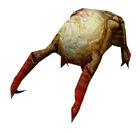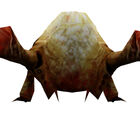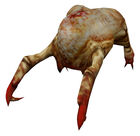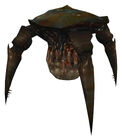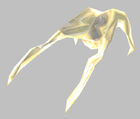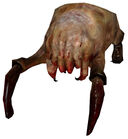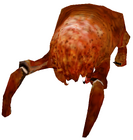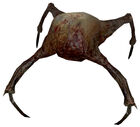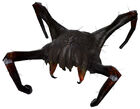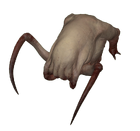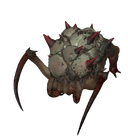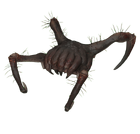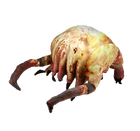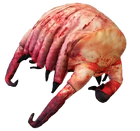- "Have you ever seen such a magnificent species? These 'crab' creatures can completely control their host's nervous system. Can you imagine what the next stage of mutation looks like?"
- ―Black Mesa scientist[src]
Headcrabs are omnivorous, parasitic alien organisms from Xen. These creatures have made an appearance in the majority of games set within the Half-Life universe. Spawning frequently throughout the course of the games, Headcrabs are guaranteed to be remembered by players of one or more Half-Life titles. Consequently, the Headcrab is considered one of the most iconic creatures in the Half-Life universe.
Overview[]
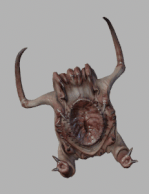
The Standard Headcrab's underbelly.
Headcrabs are alien parasitoids, roughly the size of a pumpkin. They are covered in smooth skin that varies in color between subspecies, and walk on four legs comparable to those of a spider. The shape and length of these legs relative to the mass of the body varies between Headcrab subspecies. Headcrabs are capable of leaping up to 3 meters (10 feet) in any direction, but will only perform this leap as an attack, and require a direct line of visual contact to their target before they will do so. If they miss their target when leaping, Headcrabs are placed in a disadvantageous position, as it must turn completely around at a very slow speed before attempting another. Their average weight is around eight and a half pounds, as indicated by the payload discrepancy of the rocket launched in Half-Life 2: Episode Two, where Lamarr can be seen sleeping in it before the launch.
Their underbelly is almost entirely covered by a large, jawless mouth, with a hidden 'beak' used for feeding and for latching onto the skulls of victims (see below). While they do possess what appears to be a set of four, fang-like mandibles on the front of their body, they serve no obvious purpose, and so may simply be a vestigial evolutionary relic. As seen on Xen, Headcrabs appear to be typically born out of a Gonarch; therefore, some Headcrabs are assumed to mature into Gonarchs as part of their natural life cycle, and may never use a host.
The Headcrab's natural predator appears to be the Bullsquid. In several instances, Bullsquids in Half-Life can be seen using their ranged attack to kill Headcrabs, which make no attempt to defend themselves. The Bullsquid will then feed on the dead Headcrabs.
Headcrabs were studied at Black Mesa, notably in the Advanced Biological Research Lab and the Gamma Labs.
Headcrabs are one of the three enemies in the game that can be killed with the Gravity Gun, after a few hits; the others being the Antlion Soldier and the Antlion Worker.
During the Combine occupation of Earth, Headcrabs appear to have no external sensory organs, including eyes or ears, while the Standard Headcrab appears to have 3 eyes on each side of their bodies 20 years prior. The Standard Headcrab can also be seen burrowing in and out of the ground, a behavior not shared by any other subspecies.
There are several Headcrab subspecies;
- The Standard Headcrab – the first Headcrab introduced in Half-Life, seen in their infant form near the end of the game. They turn their host into a Standard Zombie (and in some cases a Gonome).
- The Fast Headcrab – introduced in Half-Life 2, and much faster than Standard Headcrabs. They turn their host into a Fast Zombie.
- The Poison Headcrab – introduced in Half-Life 2, these Headcrabs are venomous use a neurotoxin to intoxicate and/or kill their victims. They turn their host into a Poison Zombie. It is not known if the neurotoxin alone can kill, as the HEV Suit will instantly administer an antidote. Though, if health is low and the Headcrab attacks before it can regenerate, death is imminent.
- The Armored Headcrab – introduced in Half-Life: Alyx, they possess thick, hard armor covering their backs as result of infection by a type of Xen fungus. Armored Headcrab zombies are therefore immune to headshots. To counter this, they have a vulnerable underside that is the weakest of any Headcrab subspecies, requiring only a single hit to kill them.

Headcrabs can be tamed, as seen with Lamarr (Isaac Kleiner's pet Headcrab). Headcrabs are tamed by "debeaking"; removing the beak of a Headcrab renders it unable to break into a host's head, rendering them harmless and apparently suppressing their parasitic instincts. It does not completely remove them, however, as Lamarr enjoys watermelons.
It appears that both Standard and Fast Headcrabs are edible, at least for a Vortigaunt. The Standard Headcrab can be seen being prepared by Vortigaunts in Black Mesa East and by the Quarantine Zone Vortigaunt, while fast Headcrabs can be seen being roasted by the All-Knowing Vortigaunt. The Poison Headcrabs, however, are not edible in Half-Life 2 and its episodes; if a Barnacle consumes one of them, it dies shortly after, making it an effective counter to the Barnacle. In Half-Life: Alyx, however, several Barnacles are seen eating Poison Headcrabs without any apparent damage.
Headcrabs caught in cages by the Quarantine Zone Vortigaunt cower when approached by Alyx Vance, showing that Headcrabs can be afraid when vulnerable and unable to hunt or escape.
Zombification[]
Headcrabs are a parasitic species. Upon sighting a humanoid host, a Headcrab will leap for the victim's face and affix themselves to the head, whereupon they will use their beak to break into the victim's skull. The Headcrab then proceeds to take over their host's body through an unknown biological process, however it is assumed that it will penetrate and seize control of the brain stem and thus the signals controlling the motor functions of the host body. The host will then undergo physical changes, presumably induced through chemical means; although the mutations vary between Headcrab subspecies, common changes include the deterioration of flesh (which also gives an illusion of longer fingers), reduction or removal of skin and muscle tissue across much of the body, and the exposure of the organs inside the abdominal cavity. Headcrabs keep their host alive throughout the entire process, unable to remove the Headcrab. As seen in Station 6 in Half-Life 2, it can take anywhere from several seconds to several minutes for a Headcrab to convert their hosts into Zombies.
The host appears to stay in some state of consciousness once the Headcrab has taken control. Standard Zombies retain a certain ability to talk, always heard as violent cries for help. "Zombines" seem to be able to speak with their vocoders. Each Headcrab subspecies affects their host in their own unique way, producing a Zombie extremely distinct from the other types, in both appearance and behavior.
Possible lifecycle interpretations[]
On the surface, the Headcrab lifecycle appears to defy logic. They appear to be specifically adapted to parasitize humans, a species which they had never encountered prior to the Black Mesa Incident. Furthermore, the existence of the Gonarch seems to suggest that they do not even need to find a host to complete their life cycle, which would render the entire zombification process seemingly functionless.
Since Headcrabs actually are not native to Xen, one possibility is that they are actually adapted to parasitize some yet-unseen creature on their native world, one which humans simply happen to greatly resemble by unfortunate coincidence (in Half-Life: Alyx, Alyx at one point comes across a Headcrab attempting to fuse to a mannequin, which would indicate that the resemblance is indeed a visual one, as opposed to, for example, olfactory).
If Opposing Force is taken as canon, it may also be possible that a Natural Host Creature with a Headcrab bonded to it eventually mutates it into a Gonarch, similar to how a virus mutates a targeted cell into a factory for more viruses, and that the reason this has not been seen with a human zombie is that the similarities between a human and a Natural Host Creature only go so far. It thus may also be possible that the cutting open of a zombie's abdomen is not an attempt to create a new mouth, but actually an attempt to expose whatever organ in a Natural Host Creature would later be distended into the Gonarch's birth sac.
Combine application[]
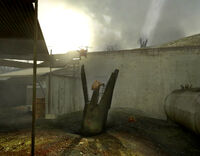
Standard Headcrabs emerging from a deployed Headcrab Shell.
In Half-Life 2, the Combine are seen utilizing Headcrabs as a form of biological weaponry against the Resistance. "Headcrab Shells," as they are known, are large mortar shells containing a payload of Headcrabs, which are released on impact, free to infect or terrorize anyone nearby. If used in large numbers, these shells are highly effective in neutralizing a large Resistance base. The effects of large-scale Headcrab shelling are seen during Gordon's visit to the devastated town of Ravenholm, where most inhabitants have been turned into Zombies.
In Episode One, it seems that the Combine have begun to lose control over their bio-weapon; Headcrabs begin infecting Overwatch Soldiers, showing that the large-scale effects of shelling have caused even Combine-controlled areas to be affected.
Behind the scenes[]
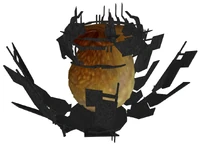
The Combine Big Momma Pod.
- Originally, a device holding a Gonarch's sack, nicknamed the "Combine Big Momma Pod" (a reference to the Gonarch's nickname), was to be used by the Combine for obtaining large numbers of Headcrabs for use in Headcrab Shells,[2] and to be encountered in the Ravenholm mine.[3] Since the device does not appear in the final games, it is currently unknown how the Combine breed their Headcrabs.
- While the Headcrabs found in Half-Life and its expansions are able to swim and survive in water but not in areas contaminated by toxic waste and radioactivity, this is reversed in Half-Life 2 and its Episodes; where Headcrabs can be found surviving in toxic areas, and drowning when entering water. The Headcrab's new resilience towards toxic and radioactive materials even appears to be passed on to the hosts they infest, as Zombies are frequently found in conditions that would otherwise be hazardous to their hosts.
- The Headcrabs in Half-Life 2 cannot attack the player if they are inside a vehicle. They will only rush at the vehicle and attempt to push it, but they end up being crushed by the vehicle instead. However, this can be advantageous to Poison Headcrabs since their attack can be very dangerous.
References in other media[]
- In Among Us, The Headcrab can be used as pet cosmetic and it is called "Bedcrab"
- A Headcrab-inspired cosmetic item named the Breadcrab was added to Team Fortress 2 in the Summer 2020 Cosmetic Case update.
- A Headcrab helm was included in the April 1, 2011 event in Vindictus as an exclusive. [4]
- A Headcrab pet was made available in a 2013 update to the action role-playing game Torchlight II. The Headcrab pet is available in versions of the game purchased both from Steam and non-Steam storefronts.[5]
- A Headcrab is an unlockable character in the Windows, OS X, and Linux versions of Super Meat Boy as an exclusive character for those who purchase the game from Steam.[6]
- A Headcrab cosmetic item was made available for the Windows version of Death Stranding released on July 14, 2020 as a tie in with Half-Life: Alyx.[7]
Gallery[]
Half-Life and its expansions[]
Half-Life 2 and its Episodes[]
Half-Life: Alyx[]
Official merchandise[]
Through the course of the years, the Valve Corporation has released several forms of merchandise based on the Headcrab model. As part of the new marketing strategies of Valve, the official website is no longer used as a storefront. Instead, the group For Fans by Fans is responsible for the distribution of official merchandise that are under Valve's intellectual property copyright protection. Specifically speaking, merchandise based on video games released by Valve and any content related to so, including the Headcrab creature. Currently, For Fans by Fans is in charge of selling the 4th model revision of the Headcrab. Discontinued and currently available official merchandise of Half-Life's Headcrabs include the following:
- Headcrab Plush Collectible Discontinued (Archived on 02-24-2011).
- Headcrab Hat Discontinued (Archived on 04-03-2011).
- Headcrab Plush Discontinued (Archived on 09-28-2012).
- Headcrab Hat Available (2015 - Present).
List of appearances[]
- Half-Life: Day One (First appearance)
- Half-Life
- Half-Life: Uplink (Non-canonical appearance)
- Half-Life: Opposing Force
- Half-Life: Blue Shift
- Half-Life: Decay
- Half-Life 2
- Half-Life 2: Raising the Bar
- Half-Life 2: Episode One
- Half-Life 2: Episode Two
- Half-Life: Alyx
References[]
- ↑ Half-Life 2: Raising the Bar
- ↑ Playable Half-Life 2 Beta files
- ↑ Playable Half-Life 2 Beta
- ↑ http://vindictus.nexon.net/News/Content.aspx?boardNo=200&contentNo=00BmP
- ↑ http://www.pcgamer.com/2013/04/02/torchlight-ii-gets-mod-editor-steam-workshop-support-pet-headcrab
- ↑ https://www.webcitation.org/68a6hQyHo?url=http://supermeatboy.com/59/You_ve_got_Headcrabs_/
- ↑ https://www.eurogamer.net/articles/death-stranding-half-life-portal-crossover-quest-6027#:~:text=Death%20Stranding%20Half%2DLife%20and,for%20the%202020%20PC%20release.&text=Completing%20these%20rewards%20you%20with,a%20Valve%2C%20er%2C%20valve
| Creatures | Alien Aircraft • Alien Controller • Alien Grunt • Archer (cut) • Armored Headcrab • Barnacle • Boid • Bullsquid • Charger (cut) • Chumtoad • Fast Headcrab • Fast Walker (cut) • Flocking Floater (cut) • Gargantua• Gonarch • Headcrab • Houndeye • Ichthyosaur • Kingpin (cut) • Leech • Lightning Dog • Mr. Friendly (cut) • Nihilanth • Panther Eye (cut) • Poison Headcrab • Protozoan • Prrobot (cut) • Quiver Creature (cut) • Sand Barnacle (cut) • Snapbug (cut) • Snark • Sphere (cut) • Standard Headcrab • Stukabat (cut) • Tentacle • Unidentified Quiver Creature (cut) • Vortigaunt • Zombie |
|---|---|
| Weapons | Black Hole Gun (cut) • Ceiling Turret • Grenade • Hivehand • Sentry Cannon • Snark • Snark Mine |
| Technology | Healing Shower • Thumper |
| Other | Crystal • Fungus • Healing Pool • Light Stalk • Trampoline • Tree |

